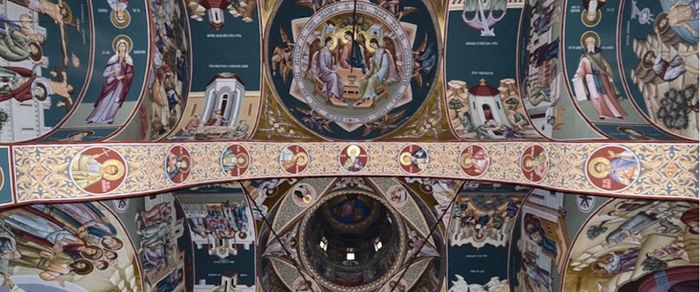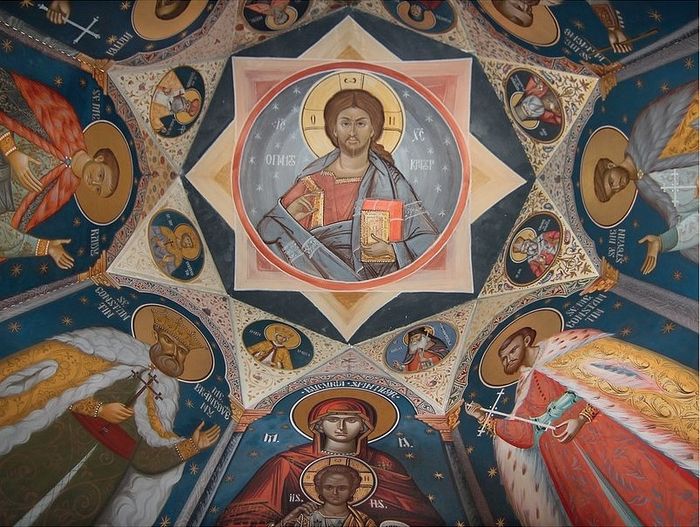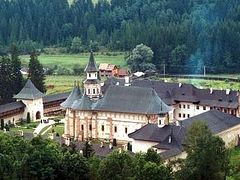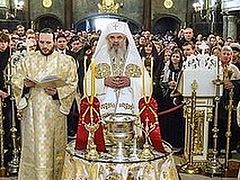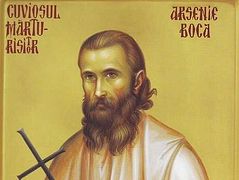Source: First Things
May 24, 2016
This monk is not letting us go without a sermon, but he’s earned it. We—a group of scholars brought together for a conference in Romania celebrating the legacy of the historian Peter Brown—have been treated well. We are standing in the Neamț monastery library, where thePhilokalia, that indispensable compendium of Orthodox thought, was first translated into Slavonic, and we’ve been permitted to hold the original translator notes. We’ve seen towering church interiors where every visible surface beams back shimmering saints. We’ve stood before a fourteenth-century icon of the Virgin Mary (miracle-working, this one), a gift from Constantinople, whose warming presence invited me to stay. We’ve stood in front of a saint’s tomb that bulged the earth above it during the communist years. Inexplicable, then or now. The scholar who told us the story, an accomplished academic fluent in eight languages, does not seem one to make up tales.
So as I said, the monk, who has facilitated our monastic tour, has earned his sermon. He asks us in Romanian, translated by our host, a simple question: What is the point of our learning about key moments in the history of Byzantium or modern Orthodoxy, if we aren’t going to be transformed by these truths ourselves? And we, all of us with Ph.D.s in some aspect of Orthodox history, smile politely, because modern academia does not have an answer to that question, inasmuch as academia is premised upon a tacit agreement never to ask it at all.
That night we arrive in a former communist hotel in Iași—for party members only—that has been turned into a dormitory for an Orthodox seminary. Freshly painted icons inhabit the brutalist niches. The food is elaborate and designed to please us. A pack of young men, some of them teenagers, form the lead monk’s faithful entourage. There are about fifteen of them. High school students majoring in theology, they are deferential to us as visiting faculty, which fills the meals with awkward silences. Until, following one meal, they get up to sing. There is little on this earth that can equal the chant of Orthodox monks at Mount Athos—a unique alarm clock able to wake up dormant parts of the soul. And this singing is Athos’s equal. Immediately I realize why this group of young men hovers around the Seminary instead of the haunting the post-communist glitz in the outdoor mall around the corner. Were I a Romanian teenager, I’d do my best to join their pack as well.
And just as old songs sung by new voices fill that room, so most of the churches we have encountered are not ancient, but barely dry. To be sure, the famous UNESCO World Heritage churches—Voroneț, Moldovița, Putna—are memorable. If painting actually counted (which it should), they could be named among the great works of early modern theology. But for every old church we have visited, there seem to be two that were built recently. Most art historians ignore these iconographical cycles, bee-lining instead to the older edifices, thereby losing the chance to witness a chapter in the history of art that is being written today. As the Orthodox Arts Journal has long been reporting, icon production in post-communist Romania is richly pervasive, nor is it mere conservative regurgitation. Some artists have created modest, human-scale churches full of architectural innovation to counterbalance gargantuan, state-sponsored projects. And as Christopher Merrill reports, there is modern artistic impact as well. In the 1980s, when churches were still being actively destroyed, the Romanian artist Sorin Dumitrescu first began to resist socialist realism with spiritual themes. Abandoning his three-pack-a-day cigarette habit while on pilgrimage to Mount Athos, he was rewarded with two visions of the Virgin Mary, which still inform his avant-garde icons. The artists surrounding his Catacomba gallery in Bucharest continue such work under his guidance.
As we drive from site to site, the earth is awakening from winter as if to illustrate this resurgence. Between site visits, I am reading Laurus, the oft-discussed recent novel by Eugene Vodolazkin about Arseny, a fifteenth-century Holy Fool. Arseny can see into the future. Somehow, despite living in the Late Middle Ages, he steps on a plastic bottle, as if foreseeing the terribly littered landscape around me that still suffers from the communist years. As I’m reading, our academic host gets up on the bus to explain at last a story so many of us have been asking about. Who is this modern saint whose picture we see in every parish church and corner market? Like the protagonist of the novel, his name too is Arseny—Arsenie Boca (1910-1989). An artist and persecuted priest, he helped with the Philokalia translation into modern Romanian, and was well established as an Abbot when communism arrived. We learn of the miracles, bilocation among them, unwittingly documented by communist authorities. For a moment, Vodolazkin’s enchanting novel does not seem so bizarre.
But most of the sanctity that I witness takes the form of ordinary kindness. One of our monastic hosts, Archimandrite Chrysostom, had been a successful professional until he encountered an emptiness that turned him to faith. As Thomas Merton said about taking the habit, it is easier than a life in the world if you do it poorly, but more difficult if you do it well. Witty, hospitable, and radiant, Father Chrysostom seems in the latter camp.
The Romanian Christians I meet do not see their Orthodoxy through rose-colored glasses. Politically speaking, all of them are concerned about the territorial ambitions of Putin’s Russia. Among the clerics, many worry that similar ambitions by the Russian church might overwhelm the long-awaited pan-Orthodox council to be held this summer. Within the Romanian Orthodox Church itself, troubles of nationalism, phyletism, and complicity between church and state remain sources of concern. But its faithful also have recourse to the great cloud of witnesses that awaits them on every church wall, and the humble resilience that—alongside non-Orthodox Christians like the Reformed pastor László Tőkés—proved a match for Communism.
But at each of the places we visit, the question comes up again, from scholars, from monks, and finally—on the eve of Lent—from a bishop: Why, we are asked, are you interested in the history of Orthodoxy if you are not transformed by it yourself? We are American, Israeli, German, and Austrian academics, each somehow connected to the legacy of a noted scholar, but we have no answer, and we wait for the moment to pass. But it is a well-intended question, as if fellow workers asked a team of weary laborers, after harvesting the earth’s bounty, why it is that they do not eat.
At any rate, on the closing night of our gathering, exceedingly grateful for the scholarship of Peter Brown, our Romanian Orthodox hosts give us an icon to take back to him. It is still too wet to pack.

